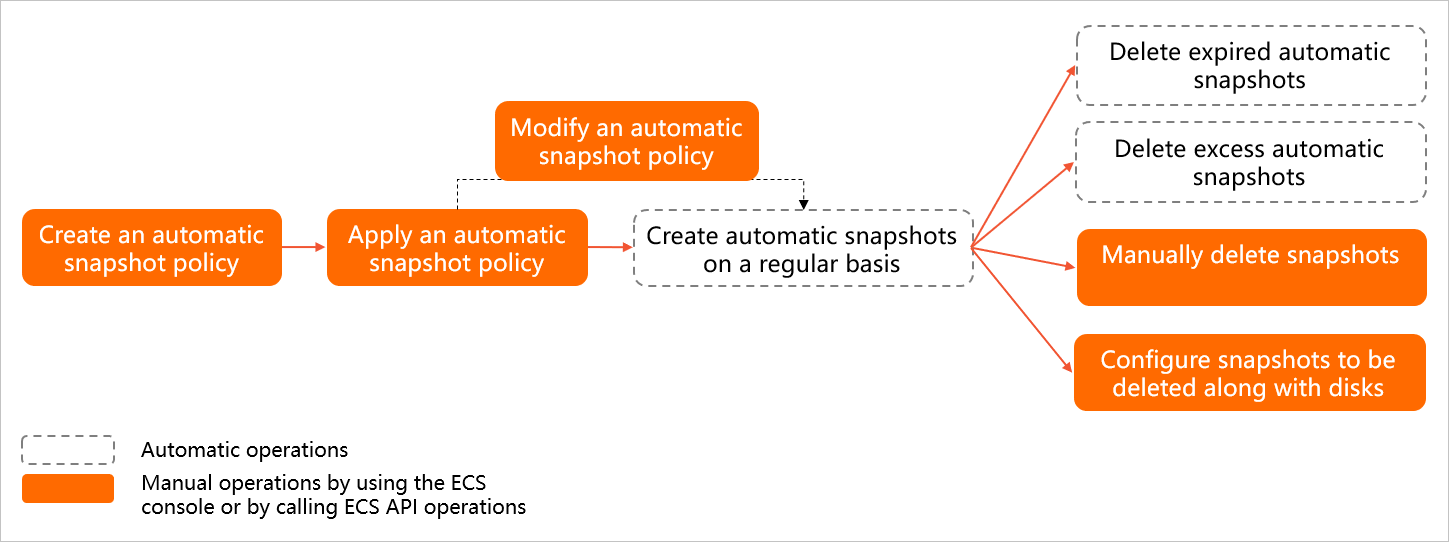Elastic Compute Service (ECS) uses automatic snapshot policies to create snapshots on a regular basis at scheduled points in time to protect data stored on system and data disks. You can use automatic snapshot policies to improve data security and fault tolerance.
Use scenario
Use automatic snapshots to back up data on disks that run critical applications on a regular basis. This allows you to quickly retrieve disk data to ensure business continuity if data loss or application errors occur due to reasons such as accidental operations and ransom viruses.
Usage notes
When you use automatic snapshot policies, take note of the following items:
Item | Description |
Automatic snapshot policy |
|
Disk type | Local disks do not support automatic snapshot policies. You can configure automatic snapshot policies for other types of disks. |
Disk status | You can create automatic snapshots only for disks that are in the In Use state. Note If a disk is in the Unattached state and has never been attached to instances, the data that is stored on the disk remains unchanged. In this case, you do not need to create snapshots for the disk and cannot configure an automatic snapshot policy for the disk. |
Create an automatic snapshot |
|
The number of automatic snapshot policies that can be configured for a single disk | 1. |
Common operations
The following figure shows the common operations that you can perform for automatic snapshots from the time when an automatic snapshot policy is created until the time when the automatic snapshots are released.
Operation | Description | References |
Create an automatic snapshot policy | Create an automatic snapshot policy and specify when to create automatic snapshots and how long to retain the snapshots. | |
Apply an automatic snapshot policy | Apply an automatic snapshot policy to a disk to automatically create snapshots for the disk on a regular basis. | |
Modify an automatic snapshot policy | Modify the information of an automatic snapshot policy, such as the start time and retention period of automatic snapshots. | |
Create automatic snapshots on a regular basis | ECS creates snapshots on a regular basis based on automatic snapshot policies. | N/A |
Delete automatic snapshots | Automatic snapshots can be deleted automatically or manually.
| |
Delete an automatic snapshot policy | You can delete an automatic snapshot policy that you no longer need. After you delete an automatic snapshot policy, the policy no longer takes effect on all disks to which the policy was applied. |
Differences between automatic snapshots and manual snapshots
Automatic and manual snapshots are point-in-time full backups of disks. They differ in the following ways:
Different creation methods
Automatic snapshots are created based on automatic snapshot policies. After you create an automatic snapshot policy and apply the policy to a disk, the system automatically creates snapshots for the disk based on the time point or interval specified in the snapshot policy. For more information, see Create an automatic snapshot policy.
Manual snapshot are created manually. On the Snapshots or Disks page, you can manually create a snapshot for the disk based on your business requirements. For more information, see Create a snapshot for a disk.
Different Creation Method values in console
View automatic and manual snapshots in the snapshot list:
The Creation Method of an automatic snapshot is Automatically Created.
The Creation Method of a manual snapshot is Manually Created.
Different names
The name of an automatic snapshot starts with auto2.0. The naming format is auto2.0_yyyyMMdd_SnapshotPolicyId.
auto2.0: the prefix of the name of an automatic snapshot.
yyyyMMdd: the date on which the snapshot is created. yyyy stands for the year, MM for the month, and dd for the day.
SnapshotPolicyId: the ID of the automatic snapshot policy based on which the snapshot is created.
The name of a manual snapshot specified when the snapshot is created.